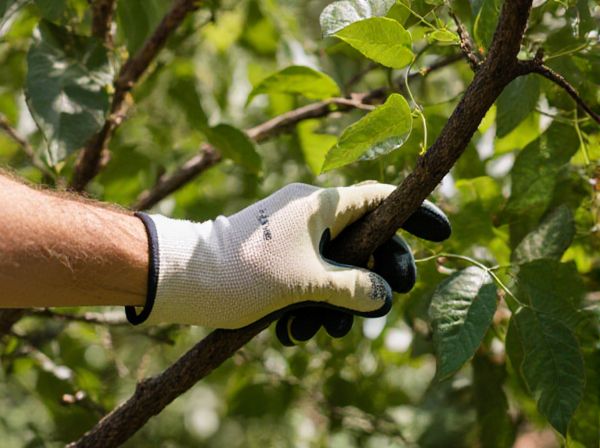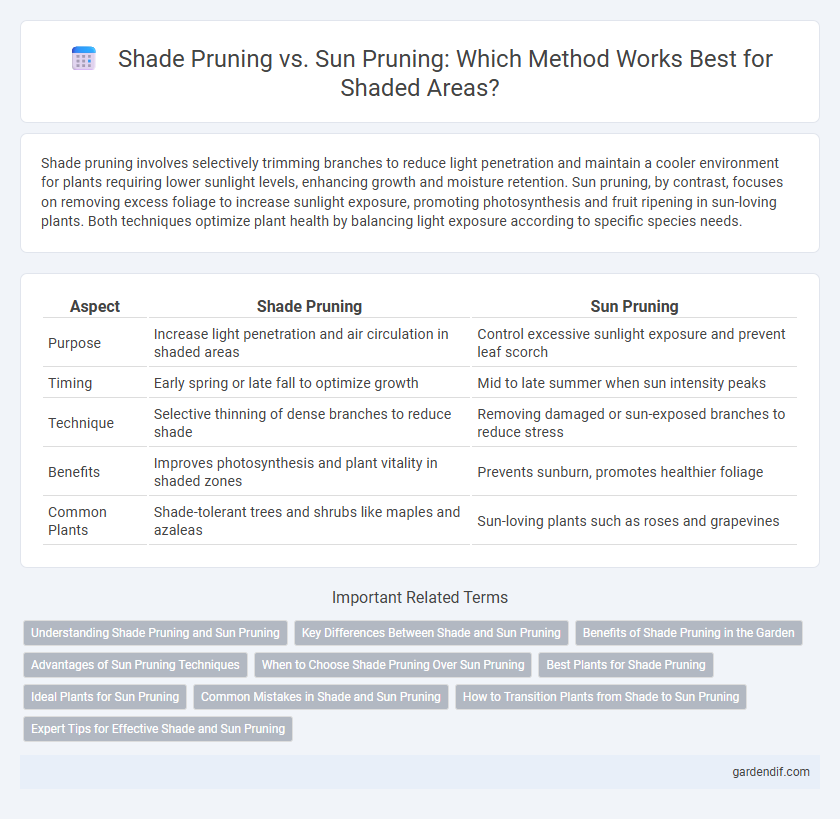
Shade Pruning vs Sun Pruning Illustration
Shade pruning involves selectively trimming branches to reduce light penetration and maintain a cooler environment for plants requiring lower sunlight levels, enhancing growth and moisture retention. Sun pruning, by contrast, focuses on removing excess foliage to increase sunlight exposure, promoting photosynthesis and fruit ripening in sun-loving plants. Both techniques optimize plant health by balancing light exposure according to specific species needs.
Table of Comparison
| Aspect | Shade Pruning | Sun Pruning |
|---|---|---|
| Purpose | Increase light penetration and air circulation in shaded areas | Control excessive sunlight exposure and prevent leaf scorch |
| Timing | Early spring or late fall to optimize growth | Mid to late summer when sun intensity peaks |
| Technique | Selective thinning of dense branches to reduce shade | Removing damaged or sun-exposed branches to reduce stress |
| Benefits | Improves photosynthesis and plant vitality in shaded zones | Prevents sunburn, promotes healthier foliage |
| Common Plants | Shade-tolerant trees and shrubs like maples and azaleas | Sun-loving plants such as roses and grapevines |
Understanding Shade Pruning and Sun Pruning
Shade pruning involves selectively trimming foliage to reduce light blockage, enhancing airflow and preventing diseases in shaded plants. Sun pruning targets removing excess branches and leaves to increase sunlight penetration, promoting photosynthesis and growth in sun-exposed areas. Both techniques optimize plant health by balancing light exposure and air circulation tailored to specific environmental conditions.
Key Differences Between Shade and Sun Pruning
Shade pruning primarily involves removing excess foliage to increase sunlight penetration and air circulation in shaded areas, promoting healthier plant growth. Sun pruning focuses on trimming parts exposed to direct sunlight to prevent sunburn and reduce heat stress, optimizing energy use for fruit production. Key differences include the pruning objectives--enhancing light access in shade pruning versus protecting from excessive light in sun pruning--and the techniques used, with shade pruning favoring selective thinning and sun pruning emphasizing selective cutting of sun-exposed tissues.
Benefits of Shade Pruning in the Garden
Shade pruning enhances plant health by increasing airflow and light penetration, which reduces fungal diseases and promotes vigorous growth. It helps maintain a balanced microclimate, protecting delicate plants from excessive heat and conserving moisture in the soil. This method also encourages the development of stronger stems and denser foliage, improving the garden's overall aesthetic and resilience.
Advantages of Sun Pruning Techniques
Sun pruning techniques enhance photosynthesis by increasing light penetration, which stimulates robust plant growth and higher fruit yield. This method reduces humidity within the canopy, lowering the risk of fungal diseases and promoting healthier foliage. Improved airflow from sun pruning also strengthens branches, resulting in a more resilient plant structure.
When to Choose Shade Pruning Over Sun Pruning
Choose shade pruning over sun pruning when managing plants in low-light environments or dense canopies to enhance airflow and prevent fungal diseases. Shade pruning helps maintain optimal leaf density, allowing sufficient light penetration essential for photosynthesis in shaded areas. This technique is ideal for indoor plants, understory trees, or shaded garden beds where sunlight exposure is limited.
Best Plants for Shade Pruning
Shade pruning enhances the growth of shade-tolerant plants such as ferns, hostas, and azaleas by removing dense foliage to increase light penetration and airflow. Plants like boxwood and hydrangeas respond well to shade pruning, which promotes healthier, more vigorous growth without sun damage. This technique is crucial for maintaining lush, dense habitats in low-light garden areas, improving plant health and aesthetics.
Ideal Plants for Sun Pruning
Ideal plants for sun pruning include sun-loving species such as roses, hydrangeas, and lavender, which thrive when pruned to maximize light exposure. Sun pruning encourages vigorous growth and flowering by removing shaded or overcrowded branches, improving air circulation and sunlight penetration. This method is particularly effective for plants requiring full sunlight to maintain their health and aesthetic appeal.
Common Mistakes in Shade and Sun Pruning
Common mistakes in shade pruning include over-thinning, which reduces essential leaf cover and stresses the plant, and improper timing that disrupts growth cycles. Sun pruning errors often involve excessive removal of foliage, exposing branches to sunscald and increasing water loss. Both practices require precise balance to maintain plant health and optimize photosynthesis.
How to Transition Plants from Shade to Sun Pruning
Transitioning plants from shade pruning to sun pruning requires gradual exposure to increased sunlight to prevent leaf burn and stress. Begin by slowly extending the daily sun exposure over one to two weeks while monitoring the plant's response, ensuring healthy adaptation to stronger light levels. Adjust watering and nutrient management to support new growth under brighter conditions and avoid over-pruning during this transitional phase.
Expert Tips for Effective Shade and Sun Pruning
Expert tips for effective shade pruning emphasize selectively thinning dense foliage to improve light penetration and air circulation, promoting healthier growth. In contrast, sun pruning requires careful removal of outer branches to prevent sunburn and stress on previously shaded leaves. Both techniques benefit from using sharp, clean tools and pruning during appropriate seasons to maximize plant vigor and resilience.
Shade Pruning vs Sun Pruning Infographic

 gardendif.com
gardendif.com